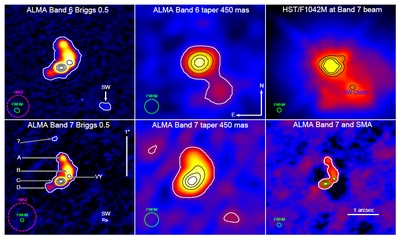- Details
- Published on 10 July 2019
Vol. 627
In section 7. Stellar structure and evolution
Massive dust clumps in the envelope of the red supergiant VY Canis Majoris
 The envelope of the red supergiant VY CMa has long been considered an extreme example of episodic mass loss. The author presents new ALMA observations at an exquisitely high angular resolution of 0.1′′ and at an unprecedented sensitivity that reveals further details about the dusty clumps known to exist within 800mas of the star. These new observations resolve new discrete features. With one exception, no molecular emission is found to be associated with the dusty clumps and this suggests that these structures have an atypically low gas content. The author carried out 3D radiative transfer modeling of the dusty clumps. The very high optical depth of all clumps to stellar radiation makes the modeling very challenging and the solutions are typically not unique. The author suggests that the dusty features have a porosity that allows a deeper penetration of stellar photons within the clumps than would be the case in a homogeneous situation. A comparison of the estimated clump ages and variations in the stellar visual flux for over a century suggests that the mechanism responsible for their formation is not uniquely manifested by enhanced or strongly diminished visual light. The study demonstrates that the dusty mass-loss episodes of VY CMa are unparalleled among all known non-explosive stars. The origin of these episodes remains an unsolved problem.
The envelope of the red supergiant VY CMa has long been considered an extreme example of episodic mass loss. The author presents new ALMA observations at an exquisitely high angular resolution of 0.1′′ and at an unprecedented sensitivity that reveals further details about the dusty clumps known to exist within 800mas of the star. These new observations resolve new discrete features. With one exception, no molecular emission is found to be associated with the dusty clumps and this suggests that these structures have an atypically low gas content. The author carried out 3D radiative transfer modeling of the dusty clumps. The very high optical depth of all clumps to stellar radiation makes the modeling very challenging and the solutions are typically not unique. The author suggests that the dusty features have a porosity that allows a deeper penetration of stellar photons within the clumps than would be the case in a homogeneous situation. A comparison of the estimated clump ages and variations in the stellar visual flux for over a century suggests that the mechanism responsible for their formation is not uniquely manifested by enhanced or strongly diminished visual light. The study demonstrates that the dusty mass-loss episodes of VY CMa are unparalleled among all known non-explosive stars. The origin of these episodes remains an unsolved problem.


